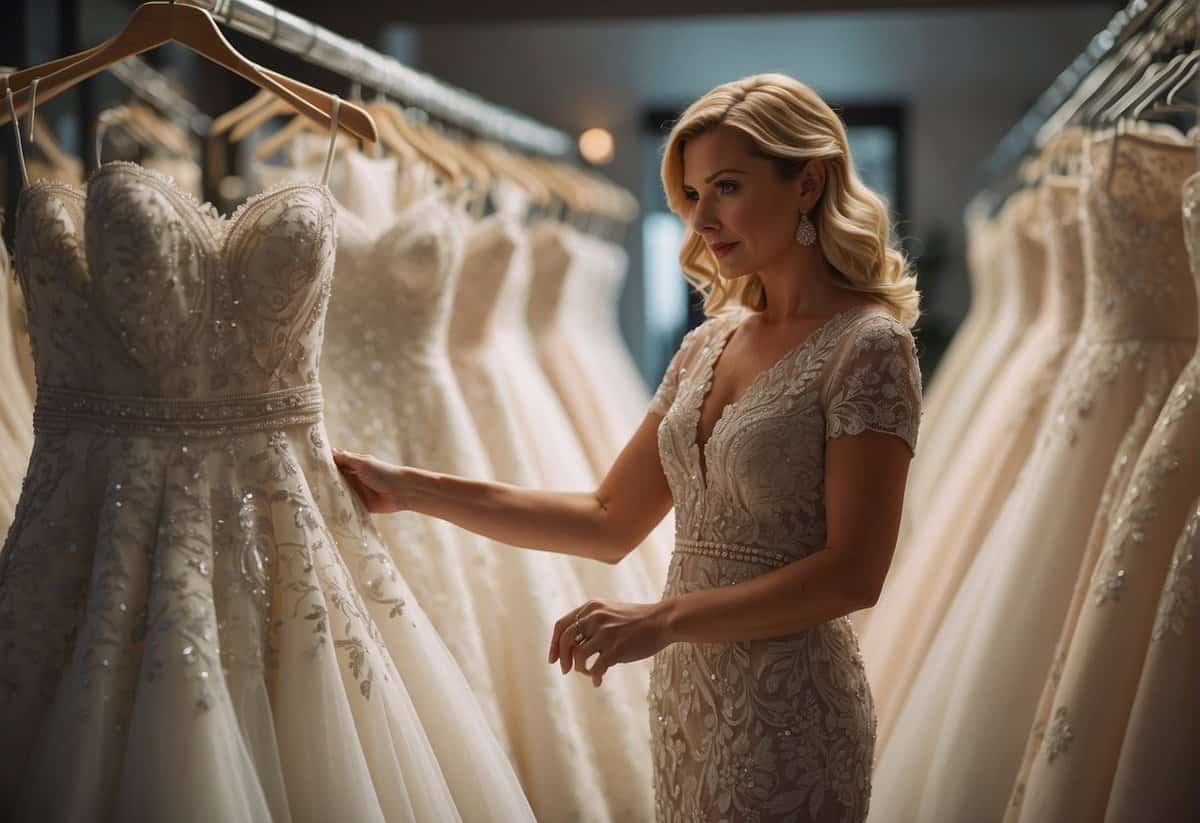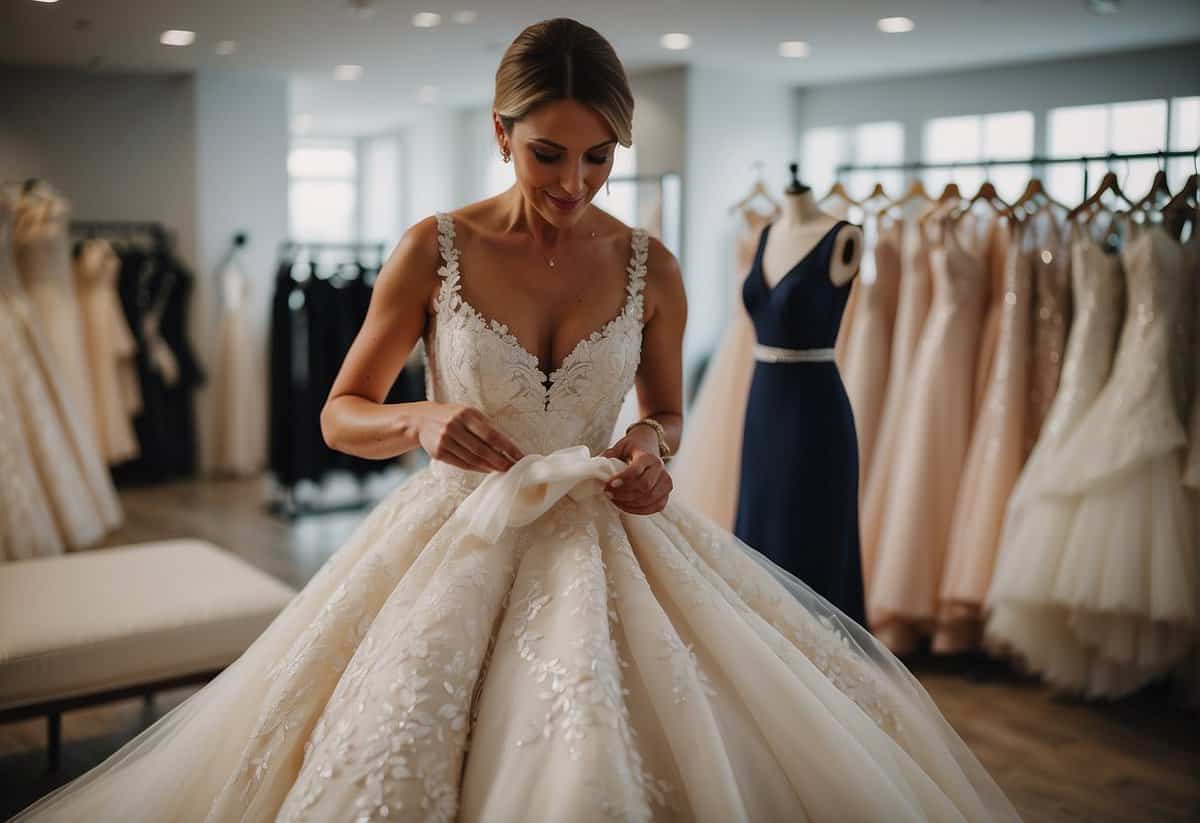Is It Customary for Mother of the Bride to Buy the Wedding Dress? Etiquette Explained
When it comes to weddings, there is a rich tapestry of customs that govern everything from the ceremony to the attire. If you are the mother of the bride, you may be wondering if it’s customary for you to purchase your own wedding dress for your daughter’s big day. Traditionally, the mother of the bride is responsible for choosing and buying her own dress, which should complement the wedding’s color scheme and aesthetic, without detracting from the bride’s gown.

While tradition serves as a guide, modern practices are flexible. You will find that the most important factors are usually budget, personal style, and the theme of the wedding. It’s also common for the bride to have an opinion on what her mother wears. The key is open communication and an understanding of the overall vision for the wedding, ensuring that everyone looks and feels their best on this special occasion.
Key Takeaways
- The mother of the bride typically buys her own wedding dress.
- Modern practices allow for flexibility in traditional customs.
- Coordination with the bride on style and theme is crucial.
Traditions and Etiquette

In the context of weddings, the attire choices of key participants are steeped in etiquette. It’s important that you, as the mother of the bride, understand these customs to ensure a harmonious and stylish celebration.
Mother of the Bride Dress Etiquette
As the mother of the bride (MOB), your dress is a significant part of the wedding day. Traditionally, you should choose a dress that complements the bridal party without overshadowing the bride. Here’s what dress etiquette suggests:
- Formality: Your dress should match the wedding’s formality; for a black-tie affair, a formal gown is suitable, whereas a semi-formal event may call for a cocktail dress.
- Color Coordination: Communicate with the bride to select a color that works with the wedding’s palette. Avoid white, cream, or ivory which are reserved for the bride.
Coordination With the Wedding Party
Coordinating your attire with the wedding party contributes to a cohesive look that photographs beautifully and looks considered. Here’s how you can coordinate:
- Mother of the Groom: It’s courteous to inform the mother of the groom of your choice so she can choose a gown that neither clashes with yours nor the bridesmaids.
- Bridesmaids Sync: While you don’t necessarily match the bridesmaids, consider a hue that complements their dresses. Clear communication with the bride will help achieve this unity.
Selecting the Perfect Dress

When you embark on the search for the perfect mother of the bride dress, you’re looking for something that balances elegance with comfort. It should reflect the formality of the occasion and complement the bridal fashion without upstaging it.
Factors to Consider
Season and Venue: The time of year and location of the wedding are vital in choosing your outfit. A floor-length gown in a heavier fabric might be ideal for a formal winter wedding, whereas a lighter, shorter dress or cocktail dress could be perfect for a summer event. If the wedding is outdoors or in a unique setting like a beach or a rustic barn, consider a dress that matches this ambiance while still letting you move freely and enjoy the occasion.
Comfort and Alterations: It’s going to be a long day full of activities, so prioritize your comfort. This means finding the right fit is crucial; alterations may be necessary, so ensure there’s enough time for that before the big date. Also, consider whether you’d prefer a dress that comes with a matching jacket or shawl especially if you are opting for for a short dress.
Styles and Options
Formality and Coordination: The formality of the wedding often dictates whether you’ll wear a long or short dress. For a very formal affair, an elegant mother of the bride gown is often floor-length. However, for less formal weddings, a knee-length dress is also suitable. When selecting the color, think about how you will coordinate not only with the bride but also with the bridesmaid dresses. Avoid exact matches but look for harmonious shades, perhaps a more subdued tone like grey.
Bridal Fashion Interplay: Your dress should complement the bride’s and the overall wedding style. If the wedding dress is very detailed, you might choose something simpler. However, if the bridal gown is minimalist, you could opt for a dress with subtle embellishments. Always remember, discreet elegance is key; the spotlight should remain on the bride.
Selecting the perfect dress for the mother of the bride involves considering the season, comfort, dress formality, and how it will pair with the wedding’s overall style. Take your time to choose a dress that makes you feel confident, is comfortable enough to wear throughout the day, and pays homage to the special role you’re playing in the big day.
Accessories and Finishing Touches

When selecting accessories for your mother-of-the-bride outfit, aim for elegance that complements your dress. Now, let’s talk about the specific pieces that will complete your look.
Jewelry and Embellishments
Choosing jewelry is all about balance. If your dress is heavily embellished, consider minimalistic jewelry. Otherwise, you can opt for more statement pieces. When it comes to metals, silver jewelry often provides a modern touch, while gold can add warmth and classic appeal. For an age-appropriate look that still feels contemporary, select pieces that resonate with your personal style without overshadowing the bride.
- Necklaces: A simple pendant or pearls can accentuate a neckline without competing with it.
- Earrings: Depending on the hairstyle and dress neckline, drop earrings or studs could be perfect.
- Bracelets: A tasteful bracelet or watch can add sophistication.
Complementary Attire Details
Your outfit extends beyond the dress. If you’re opting for a formal black dress, coordinate with shoes and a clutch that complement the elegance of the occasion. For a less traditional look, a jumpsuit can be both stylish and appropriate, especially when paired with polished accessories. Always consider the dress code of the wedding and choose details that enhance your outfit’s formality.
- Shoes: Comfort is key, but don’t sacrifice style. Heeled pumps or sophisticated flats are both great choices.
- Clutches or Handbags: Select a bag that’s both functional and fashionable; it should carry your essentials without being bulky.
Remember, accessories are not just add-ons but an integral part of crafting a cohesive, occasion-appropriate look.
Preparation and Final Considerations

As you approach the final stages of wedding planning, it’s important to focus on the details that ensure a smooth experience. This includes meticulous attention to the bridal attire and coordinating the day-of events.
Final Fittings and Alterations
Your wedding attire, especially if it’s a mother-of-the-bride attire, may require final fittings and alterations to ensure it’s perfect for the wedding photos. Schedule these appointments well in advance, and consider the wedding’s setting; a beach wedding or an outdoor wedding might necessitate different styles or fabrics to suit a more laid back atmosphere. The fit should be comfortable enough to move freely, yet flattering to the silhouette. Remember, alterations should be completed at least two weeks before the big day to account for any last-minute adjustments.
- Checklist for Final Fittings:
- Ensure proper fit for comfort and appearance.
- Confirm style appropriateness for the venue (e.g., beach, outdoor).
- Allow time for additional adjustments post-final fitting.
Day-of Coordination
On the wedding day, coordination is key. You’ll want to work closely with the wedding planner or designated coordinator to make sure timelines are adhered to. If compromises are needed due to unexpected changes, be ready to make swift decisions. Your mother of the bride attire should be ready to go early in the day to avoid any rushes, and always account for the little things, like comfort items or a change of shoes. A calm, prepared mother of the bride sets the tone for a relaxed and joyful celebration.
- Day-of Coordination Tips:
- Confirm the schedule with the wedding planner.
- Prepare an emergency kit for quick fixes (safety pins, stain remover, etc.).
- Designate a go-to person for last-minute needs.
Frequently Asked Questions

When planning a wedding, the attire can be a significant focus, and you might have questions about etiquette and traditions, especially when it comes to who buys the bride’s wedding dress. Here are some frequently asked questions to guide you.
Who is typically responsible for purchasing the bride’s wedding dress?
Typically, the bride’s family is responsible for purchasing her wedding dress. However, this can vary based on individual circumstances and preferences.
What are some meaningful ways to involve the mother of the bride in the wedding dress shopping experience?
To involve the mother of the bride, she can accompany the bride to fittings and help select the perfect gown, offering support and sharing the special moment together.
Does the mother of the bride usually select a dress that matches the bridesmaids’ attire?
The mother of the bride does not usually match the bridesmaids’ attire but may choose a dress in a complementary color or style to maintain a cohesive look.
What is considered proper etiquette for the mother of the bride’s dress at the wedding?
Proper etiquette suggests that the mother of the bride’s dress should be elegant, fit the formality of the event, and she should avoid wearing white or ivory, which are traditionally reserved for the bride.
Is it common practice to include the mother-in-law in wedding dress shopping excursions?
It is a thoughtful gesture to include the mother-in-law in wedding dress shopping, ensuring she feels valued and can share in the excitement.
What are the traditional responsibilities of the mother of the bride when it comes to the wedding attire?
Traditionally, the mother of the bride might help in selecting her own outfit and often buys her own dress for the special day, reflecting her personal style and the wedding’s overall tone.

